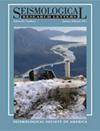Microseismic Event Location with Dual Vertical DAS Arrays: Insights from the FORGE 2022 Stimulation
IF 3.2
3区 地球科学
Q2 GEOCHEMISTRY & GEOPHYSICS
引用次数: 0
Abstract
We investigate the resolvability of a microseismic event location given a recording array composed of vertical distributed acoustic sensing (DAS) boreholes. We use a modified source‐scanning algorithm that takes into account both P and S waves. We transform the brightness maps it produces into probability density functions (PDFs), over which we carry out a resolution and uncertainty analysis. We apply this approach to microseismic events recorded by two vertical DAS boreholes as part of the Frontier Observatory for Research in Geothermal Energy (FORGE) project. We show that for the specific acquisition geometry in FORGE, the horizontal location of the events cannot be determined, but their depth can, similar to results obtained with a single borehole. Using synthetic examples, we show that the recording array’s geometry is the limiting factor in the determination of the horizontal location. We investigate various possible recording geometries composed of idealized DAS‐like vertical boreholes with varying locations and depths. We find that, besides the number of recordingd boreholes, their depth is the main factor influencing the location estimation uncertainty. The number and position of the boreholes mainly influence the spatial distribution of the PDF, whereas the boreholes’ depth mainly influences its size. Despite the simplicity of our analysis, it highlights the influence of the monitoring array design for microseismic events’ locating using vertical DAS arrays.使用双垂直 DAS 阵列进行微地震事件定位:FORGE 2022 刺激项目的启示
我们研究了由垂直分布式声学传感(DAS)钻孔组成的记录阵列对微地震事件位置的可分辨性。我们使用了一种改进的震源扫描算法,该算法同时考虑了 P 波和 S 波。我们将其生成的亮度图转换为概率密度函数 (PDF),并对其进行分辨率和不确定性分析。我们将这种方法应用于地热能研究前沿观测站(FORGE)项目中由两个垂直 DAS 井眼记录的微地震事件。我们发现,对于 FORGE 项目中的特定采集几何形状,地震事件的水平位置无法确定,但其深度可以确定,这与单个钻孔获得的结果类似。通过合成实例,我们表明记录阵列的几何形状是确定水平位置的限制因素。我们研究了由不同位置和深度的理想化 DAS 型垂直钻孔组成的各种可能的记录几何结构。我们发现,除了记录钻孔的数量外,其深度也是影响位置估计不确定性的主要因素。钻孔的数量和位置主要影响 PDF 的空间分布,而钻孔深度则主要影响 PDF 的大小。尽管我们的分析很简单,但它强调了监测阵列设计对使用垂直 DAS 阵列进行微震事件定位的影响。
本文章由计算机程序翻译,如有差异,请以英文原文为准。
求助全文
约1分钟内获得全文
求助全文
来源期刊

Seismological Research Letters
地学-地球化学与地球物理
CiteScore
6.60
自引率
12.10%
发文量
239
审稿时长
3 months
期刊介绍:
Information not localized
 求助内容:
求助内容: 应助结果提醒方式:
应助结果提醒方式:


